
Topics
Guests
- James Ridgewaywriter for The Village Voice.
- Tod Ensignco-founder of Citizen Soldier, a GI veterans’ rights advocacy organization.
Today is the first anniversary of the bombing of the Alfred Murrah Federal Building in Oklahoma City, an event which drew national attention to the burgeoning armed anti-government militia movement in the U.S. We speak with James Ridgeway, writer at The Village Voice, who has been investigating and writing about the evidence against the two accused of orchestrating the Oklahoma bombing: Terry Nichols and Timothy McVeigh. We also speak with Tod Ensign of Citizen Soldier, a GI veterans’ rights advocacy organization.
Transcript
AMY GOODMAN: You’re listening to Democracy Now!, Pacifica Radio’s daily grassroots election show. I’m Amy Goodman, here in WPFW’s studios of Pacifica in Washington. And Juan González, my co-host, is joining me in New York. Juan, welcome.
JUAN GONZÁLEZ: Good morning, Amy. And today is the one-year anniversary of the bombing of the Alfred Murrah Federal Building in Oklahoma City, an event which drew national attention to the growing armed anti-government militia movement in the U.S. And we have two guests today. One here in New York is with me, Tod Ensign of Citizen Soldier, a GI veterans’ rights advocacy organization. And Tod is the author of a forthcoming article in CovertAction Quarterly on right-wing groups within the U.S. military.
AMY GOODMAN: And Jim Ridgeway is joining me here in Washington. He’s a writer for The Village Voice who’s been investigating and writing about the evidence against the two accused of orchestrating the Oklahoma bombing, Terry Nichols and Timothy McVeigh.
Jim, why don’t we begin with you? What theories are the defense putting forward right now?
JAMES RIDGEWAY: Well, the defense is going to use several different ways of trying to shake the government’s case. I mean, the first thing is they’re going to have witnesses, people who say that McVeigh wasn’t where he was at the times where the government says he was. There will be all different kinds of people who will begin to question whether Tim McVeigh was anything more than a stand-in or a fall guy in this whole deal.
The second thing is the defense, I think, will try to sow the seeds of the concept that there was a conspiracy involved here, a neo-Nazi conspiracy at the bottom, and perhaps this neo-Nazi conspiracy reaches out to Germany, because the defense has at least one, if not a couple of individuals who are Germans, who come out of the German — or, potentially come out of the German neo-Nazi movement and who have been in the United States and who were in fact in Oklahoma — one of them was in Oklahoma — and to whom Tim McVeigh apparently made a telephone call shortly before all this happened.
And then, there’s another possibility, international possibility, which Stephen Jones, the McVeigh attorney, is trying to develop, which is a larger international plot — sounds rather far-fetched, but he claims to have documentation that the Iraqis were somehow interested in this.
And finally, the most interesting aspect of this whole thing is the possibility, which seems completely crazy on the surface, that the government itself had prior knowledge and may actually have been involved in some kind of a sting operation against the neo-Nazi movement, a sting that got out of control.
JUAN GONZÁLEZ: But, Jim Ridgeway, how does the government expect the American public to believe that McVeigh and Nichols acted alone, when it itself initially put out this portrait of John Doe number 2? What ever happened to John Doe number 2? And to what degree does the existence of a larger conspiracy play into a defense role for these, the two accused?
JAMES RIDGEWAY: Well, I think the government has sort of like, kind of like lost it, in a certain sense here, because, I mean, the government did indeed bring up the subject of John Doe number 2 and then sort of, like, is going to say they couldn’t find him. And the defense has now taken over all these conspiracy ideas, floating them, so that the jury pool in Denver will certainly have read about the possibilities of a conspiracy, and even an international conspiracy. And what’s a juror to do, after all? I mean, if this guy McVeigh appears to be a stand-in or fall guy or a little guy in some huge conspiracy plot, I mean, ought he to be put to death? I think you’ve got to remember, these attorneys are all death penalty attorneys. They’re really looking here to the second phase in this case, which is they want to get — they want to keep McVeigh from getting killed.
JUAN GONZÁLEZ: And in terms of the — you, in some of your articles, relate the civil suit, that some of the victims have against McVeigh and Nichols, and the relationship between this Tulsa lawyer, Larry Oliver, and the defense attorneys. How are the plaintiffs in a civil suit involved in a relationship with the defense attorneys?
JAMES RIDGEWAY: Well, it’s a little like the O.J. case. It’s where you have — you have this criminal suit, this criminal case, and then you have a civil case that’s brought by — in this instance, by the grandfather of two of the dead children. He’s brought the case against McVeigh. Now, this is a civil case, and they can do all sorts of discovery in a civil case which you might not be able to do in a criminal case. And so, these two cases, although they involve different attorneys and different sets of people, in a way, work together to feed each other. And as I understand it, the judge in the criminal case has allowed Jones, the attorney for McVeigh in the criminal case, money to conduct an investigation to essentially defend McVeigh, not so much in the criminal case, but in the civil case, so that Jones is able to go abroad, he’s able to take trips abroad, to look into the German question, the possibility that some right-wing Britons were involved in this and so on. So these two cases kind of like work together.
And the big thing, though, the really big thing, is that since McVeigh doesn’t have any money, if the civil case were to be successful, if it were to turn into some sort of a class action kind of case on the basis of all these victims, it would have to be brought against the government. And, I mean, clearly, the attorneys see the potential here, and so do the victims, of a Ruby Ridge multiplied by billions and billions. And if they can show, in any way, shape or form, that there was prior knowledge by the government in this awful thing, they could stand to succeed.
AMY GOODMAN: Now, Jim, you talk about, in your articles, the United States government, the FBI infiltrating the militia movement. Can you talk about that? And then, how unlikely is it that the FBI might have known?
JAMES RIDGEWAY: Well, I certainly am one who never took the prior knowledge thing very seriously. And when the John Birch people brought this up to begin with, I thought it was completely nuts. In other words, these are the people who are going around saying that the government blew up the building. I just thought that was a horrible kind of joke. But I must say, in the last couple of weeks, there’s information that’s been coming out that really raises some questions.
There is a case in eastern Oklahoma, in Muskogee, called the Lampley case. Lampley was a guy who hung around Elohim City, which is a far-right community, Christian Identity community, down in eastern Oklahoma. And after Oklahoma City bomb, he came up with an idea of building his own bomb. And he was going to go off and kill Morris Dees and the Southern Poverty Law Center people and the ADL in Houston. He constructed this bomb, and he had — and in the process of doing all this, an FBI informant, confidential informant, became involved with him and followed him. He then sought help to get explosives, and he sought it from the Tri-State Militia, a group in South Dakota. He talked to a guy named Parsons in the Tri-State Militia. Parsons is a former truck driver. And he was sort of the only guy, really, in this Tri-State Militia. He had a couple of fax machines. He had an 800-number. And he was connected to a whole lot of other militias.
Well, in this trial of Lampley, which is now ongoing in Muskogee, Parsons testified. And he testified that his major source of income came every month in cash, of the amount of $1,775, something like that, from the FBI. So he was a paid employee of the FBI. And the FBI denies that he’s an informant. And yet Parsons has admitted on the stand that he took trips for the FBI to try to defuse some of these bomb plots that were going on.
So, in fact, what we have here is an absolutely clear, cut and dried infiltration, penetration, of the entire militia movement across the United States by the Federal Bureau of Investigation since the Oklahoma City bombing. And that then raises the question of: Well, what was going on before? I mean, that they were able to do this with such ease afterwards, well, what were they doing before?
Just one more point. I know this drags on, but you’ve got to remember that the FBI has methodically infiltrated the Ku Klux Klan and these right-wing groups since the 1940s. It has pitted them against each other. Its informants, its agents have been very much involved. So it’s really hard to believe, in fact, that there isn’t some kind of infiltration of what now is called the far right.
JUAN GONZÁLEZ: Well, I’d like to get our other guest, Tod Ensign, involved. Obviously, Timothy McVeigh was an Army veteran himself. And there was a recent report by the Department of Defense looking at the activity of extremist groups within the military, that was issued in March, which basically discounts the possibility of extensive involvement of right-wing groups within our own armed forces. Tod, you’ve looked at that report, and you’ve been studying this for some time. What’s your reaction?
TOD ENSIGN: Well, Juan, the report was really necessitated by the murders of two Black citizens down in Fayetteville in December. You’ll recall that three white members of the 82nd Airborne went out and drove around Fayetteville at night looking randomly for victims, and they murdered these two young Black — a man and a woman on the streets of Fayetteville. That, of course, as it should, stirred enormous outrage, because these guys had been serving at the 82nd Airborne on Fort Bragg for a couple years.
And one of the things that’s come out in our investigation, Juan, is that the police, the local police, as well as the FBI, as well as Pennsylvania district attorneys, had been reporting, consistently, problems with these extremist skinheads on the base — attacks on college students, fights between the skinheads where people were shot. And this guy Burmeister, who’s the principal defendant here, he had actually called up a local police chief in Pennsylvania and threatened his life and said, “I’m an Airborne ranger, and I can come off that base with any weapon I want and murder you.” And yet the command did nothing.
So what do we have here is an out-of-control situation on the base, which the command refused to do anything about. It results in terrible, heinous crimes. And now the military — the Army, in this case — rushes in and says, “Let’s take a look. Let’s see what’s happening.” And what they said was “Not much is happening.”
JUAN GONZÁLEZ: But so, they didn’t conclude, though, that it was an isolated instance. They just said that the percentages or the numbers of soldiers who have been approached by extremist groups or have been attempted to be recruited has been small. What’s your reaction to that?
TOD ENSIGN: Yeah, they said there was “minimal evidence” of right-wing extremist activity. That was their quote. I think they should read their own report more carefully. You know, these guys, these blue-ribbon guys, they fly them in from somewhere. They sit around a room and have $12 sandwiches. And they tell them what the report says, and that’s it. And that’s a problem with this report. In fact, when they surveyed, they found that 17% of the people — 17,000 people surveyed — said that they had contact with extremist literature. To me, that’s almost one out of five. I think that’s alarming. There’s 7% said they knew somebody who they believed was a member — or, excuse me, was a right-wing extremist. These are very large figures, I think. And so, Togo West’s report really, I think, was intended to calm Congress, calm the American people. But, in fact, I think it’s a much deeper problem.
AMY GOODMAN: What about the paraphernalia on bases, the paraphernalia we associate with extreme-right-wing groups — say, a Confederate flag and things like that?
TOD ENSIGN: Well, you know, that Confederate flag issue has revived again, as you know. What I saw down there — I was down there last month — is they now have taken a twist on the Confederate flag. The bumper stickers now say things like — it has a Confederate flag, and then it says, “The South was right.” Now, I don’t know exactly what that’s supposed to mean. The other one has a Confederate flag flying over the Capitol building, and it says, “I have a dream.” So, these bumper stickers are pretty common, on base and off. They also sell, right at the base entrance, in these Army surplus stores, manuals, Army manuals, incendiary devices, unconventional weapons, this sort of thing — are being sold. So, any GI who has the slightest interest can clearly figure out how to make a fertilizer bomb.
JUAN GONZÁLEZ: And to either one of you, either Jim Ridgeway or Tod Ensign, what is the relationship then between this developing, this growing right-wing movement within the military and the civilian counterparts in the general society?
JAMES RIDGEWAY: Well, if I could just say briefly, you know, the whole problem here is that the far right is not perceived as a political movement. It’s thought of as a bunch of nuts or psychos, and the FBI has these behavioral scientists who try to psych out every one of them, you know. But it’s actually a political movement. This is a nativist movement. It’s been going on for an awfully long time. It’s not only active in the military; it’s active in the prisons. I mean, it’s really active in the prison system. And it stretches now all across the country, from the West Coast down through the Ozarks. There’s an actual white resistance, you know, people operating in cells. And everyone goes along, and they say, “Oh, well, you know, just a few guys here and there.” I mean, it’s just like a failure to accept reality, if you ask me.
JUAN GONZÁLEZ: When I was doing some reporting on prison gangs a couple of years ago, the Latin Kings and others, in interviewing federal officials and people who study gangs, the largest gang in the prisons of the United States are the Aryan Order gangs that are in almost every prison throughout the country.
TOD ENSIGN: Well, right after the Oklahoma bombing, in Fort Bragg, the National Alliance, which is one of the large far-right groups — and its head is a guy named Dr. William Pierce, who is the author of The Turner Diaries, which contains a scenario in which the FBI headquarters building is bombed with a fertilizer bomb at 9:15 in the morning. That’s one of the little scenes in the book. That book is widely read, as Jim or anyone who studies this knows. In fact, I believe McVeigh was believed to have a copy of the book. At any rate, the National Alliance put a billboard up at the entrance to Fort Bragg saying, “If you want more information about our group, call this toll-free number.” This was after the Oklahoma bombings. Now, again, I don’t want to see too many conspiracies here, but these folks are hard at work at outreaching. One in five of the people the West Commission polled said, “Yeah, I’ve had contact with extremist literature.” How many people in New York have seen the extremist literature in the last year? I don’t think 17%.
AMY GOODMAN: Tod, is it true that the Canadian government is reconsidering its military relationship, at least as far as sending soldiers to Fort Bragg to train?
TOD ENSIGN: Yes. That has become a big issue in Canada. The Canadian Airborne Regiment had trained down there for years. By the way, many, many special forces units from all over the world train at Fort Bragg. Fort Bragg is the world center for special forces operations. And one of the things the West report said was that the special forces is in danger of becoming an all-white organization. There are very few minorities in the special forces and also in the combat arms, in general. And so, you see a trend here, which even the West people were concerned about. So the Canadians have said, “We’re not sure we can allow this kind of operation.” The Airborne Regiment went off to Somalia. They murdered — one of them they did on videotape. They murdered five or six Somalian citizens.
AMY GOODMAN: The Canadians.
TOD ENSIGN: The Canadian Airborne Regiment. And this, in Canada — I think it’s a good sign — caused such a stir that they’ve now disbanded that regiment.
JUAN GONZÁLEZ: Well —
AMY GOODMAN: Jim Ridgeway? Go ahead, Juan.
JUAN GONZÁLEZ: No, yeah, I was just going to ask Jim, in terms of the continuing growth of the — you’re saying that the country is not regarding this as a political movement. Do you think that, following the Oklahoma bombing, that this has actually created a spurt or a further growth of the militia and right-wing movement? Or do you think that more and more people have been turned off and realize the increasing danger of this movement?
JAMES RIDGEWAY: No, I think it’s really strange. I think it’s encouraged and increased it. I mean, who would have thought that the concept that the government blew up its own building would be taken seriously? I mean, it’s really hard to grasp this. But this is going to become, in one way or another, a plank, a basic bottom, in this trial, in the defense of this trial. And it’s going to be discussed in some detail. I never would have thought that. I think the far right has been extraordinarily successful in building, since the 1980s, both an overground and above-ground political apparatus and an underground. I mean, you see this underground was busted — the Order was locked up and busted, but then they went to the cell structure, to the leaderless resistance cells. And it seems to me they’ve been quite successful.
AMY GOODMAN: How successful has the government been in prosecuting far-right groups involved with violence?
JAMES RIDGEWAY: Well, the government has, you know, a pretty horrible record here. I mean, they tried to bring cases during the Second World War. Roosevelt tried to crack down, and they just disintegrated into farces. There was a seditious conspiracy case that the government brought against the leaders of the far right at the end of the 1980s, which was lost. I mean, the —
AMY GOODMAN: Which group?
JAMES RIDGEWAY: See, the far right is made up of all these different little groups, put together in a movement. So, they brought together — so they brought a case against the leaders on a conspiracy case: Miles and Butler, Louis Beam, several of these better-known people. And the government lost the case. And, in fact, it was in that case that one of the snitches, who had been a leader in the movement, said that they had been planning to blow up the Oklahoma City Federal Building. And, you know, the case was such a disaster that one of the jurors married one of the defendants in this case. And currently — I mean, then the Weaver thing happened. And who knows what it will do?
AMY GOODMAN: Ruby Ridge. Well, Jim Ridgeway, Tod Ensign, they’re our guests, and we’re going to come back to them. Jim Ridgeway, writer for The Village Voice, has been covering the far right, is author of the book, Blood in the Face, as well as the documentary by that title. Tod Ensign is with Citizen Soldier, a GI veterans’ rights advocacy organization. When we come back, we’re going to bring this specifically to the presidential campaign and to one Patrick Buchanan. Stay with us.

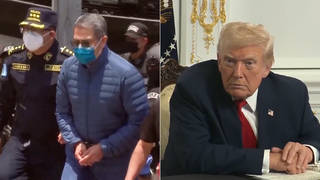
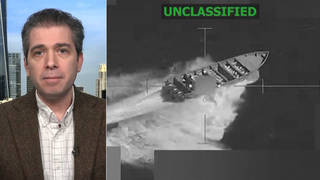
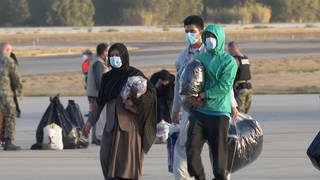
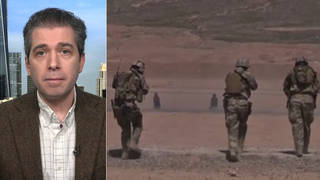





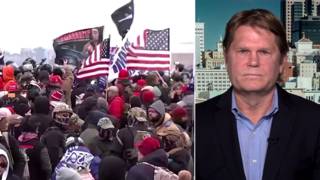

Media Options